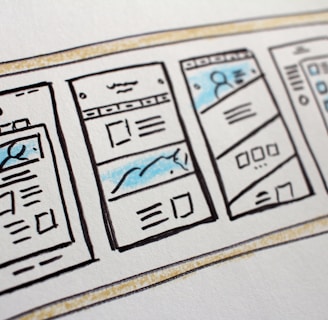
Alert: Google Business Profile Websites to be Turned Off
If your website has been built using Google Business Profile, you need to take urgent action before March
ALERTS
Steph
1/23/20245 min read
Alert: Google has announced that websites created using Google Business Profile will be turned off in March.
Once the site has been turned off, Google advises, anyone trying to reach it will be redirected to your Business Profile instead. This redirect will however only work until 10th June 2024. After this date, visitors will hit a "page not found" error when attempting to visit your website.
If you still need a website for your business, you should think about migrating your content to an alternative platform or hosting service. Don't forget to also update your Business Profile with your new website address.
Read Google's Documentation regarding Business Profile Websites being turned off.
How to build a new website
Building your website doesn't need to be difficult - you don't need years of coding experience, or any for that matter.
You'll need to decide which platform or hosting service you'd like to use, but from there, the process should be quite simple. Most service providers offer templates covering pretty much any website and industry you can think of. Once you've selected your template, some platforms now use AI prompts to help design your perfect site, otherwise, the creation process is pretty much drag-and-drop.


Keep in mind your website and audience
Choose your platform (see Google's recommendations)
Select a template or use the AI interface
Customise your site with relevant content and images
Make sure you have links to all of the pages you wish to surface
Get friends, family, or an SEO specialist to review your site
Publish your site
How I built my website
After conducting my own online research, I decided to go with Hostinger as my hosting platform. I was able to purchase 2 domains: www.this-is-seo.co.uk and www.this-is-seo.com
This is something you may want to consider if you're a UK business and you're purchasing a domain. I went for .com and .co.uk, then implemented a redirect from .com to the .co.uk website. This way, if anybody types www.this-is-seo.com into their address bar, they'll still land here, at www.this-is-seo.co.uk.


Once I'd registered my domains, I set about creating my website. I kept in mind the services I would be offering, my knowledge and experience, and what information a visitor might want to find if they were to come across my site.
Homepage: The main web page, explaining the basics of my business and linking across to the rest of my site.
About: For visitors to learn more about my goals and experience.
Portfolio: To share some of my successes and give visitors a better idea of my experience in the SEO field.
Testimonials: So you don’t just have to take my word for it.
Services: So visitors can learn more about the SEO services I provide and whether they're suited for their business.
Pricing: To be transparent with businesses about the cost of my services.
Contact: So visitors know how to best get in touch with me.
SEO Scribbles (the blog): To keep visitors up-to-date on the latest in SEO.
Having created the website, I also set up an email box and set the website live, ready to be discovered online.
What is a redirect?
A redirect is a web technique that forwards traffic from one URL to another. In this case, the traffic will no longer hit the original URL, it will instead go straight to the new, target URL. This technique is often used if a URL changes, if a web page no longer exists, or if changes need to be made to a page.
Recommended by Google
Now that you know the very basics of creating a website, here are some of the platforms recommended by Google:
Wix - Free and paid options available
Squarespace - Free 14-day trial
GoDaddy - Build for free then pay for a hosting plan
Google Sites - Free to build, host and maintain. You can pay for a custom domain name
Shopify - Free 3-day trial then currently £1 per month for 3 months
WordPress - 6 plans, including a free, basic plan


Wix
Wix is a single-platform website builder. It has over 900 free, customisable templates to choose from. Alternatively, you can start your site from scratch using a blank template. You will be able to host your website on a free Wix domain or to pay for a custom domain.
Squarespace
Squarespace provides website templates, making it easy for you to design your site. Beyond this, you'll be able to use their marketing tools and set up marketing campaigns. According to their homepage, you can also get a free custom domain name for the first year with an annual website plan.
GoDaddy
GoDaddy boasts hundreds of industry-specific websites and now also offers AI-powered services. Aside from a custom domain, you'll also be able to create a matching email address and use built-in tools for SEO, email marketing, and social media. Their homepage integrates reviews, demonstrating trust in their brand and services.
Google Sites
Google Sites allows you to create websites without programming experience or knowledge of code. You'll need to sign into your Google account in order to use this service. Once logged in, you can select a template or start with a blank website. Google Sites is specifically for sharing information rather than selling services, so isn't the best option if your website is a store.
Shopify
Shopify is currently offering a free trial, with a further 3 months at £1 per month. The platform is aimed at web stores, as you will probably have guessed from the name. You can select a customisable template and add apps for even more functionality. Furthermore, you can leverage Shopify's tools for SEO, social media, and content marketing.
WordPress
WordPress offers domains starting at £10 per year. The platform offers 6 different hosting plans, starting at £6. You can use their website builder to select a theme and then drag and drop features across your site. WordPress has over 5000 available add-ons at your disposal, such as MailChimp, Google Analytics, and Yoast.
Closing Comments
If you built your website using Google Business Profiles, you will need to create a new site before June, preferably March 2024. There are plenty of platforms available if you're looking to create a new site, some of which we've had a brief look at in this blog post.
Consider your website requirements and target audience before selecting the platform best suited to your needs.
Note: The list of platforms in this blog post was not selected by This is SEO, rather I simply provided supplementary information regarding the platforms that Google had already recommended in their support documentation. I also included Hostinger, as it's the platform I use to host my domain and create my site. None of the links within this post are affiliate links, nor have I been offered anything in exchange for my comments.
Learn more from SEO Scribbles
Location
Liverpool
United Kingdom
Contact
+44 (0)7842 275 080
contact@this-is-seo.co.uk
Social
Personal LinkedIn
Business LinkedIn



